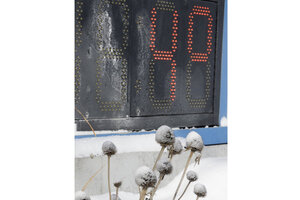Preparing for an Arctic blast: How to prevent your pipes from freezing
Freezing temperatures are forcing many Americans who are not used to prepping their homes for cold to worry if they have done enough to protect their pipes from freezing.

Plants covered with snow appear in front of a sign recording the temperature at 4 degrees on Thursday in Mayfield Heights, Ohio. Ohioans bundled up for sub-zero wind chills on Thursday and braced for continued bitter cold temperatures and plummeting wind chills. This raises the concern of possible frozen pipes across many states experiencing similar cold.
Tony Dejak/AP
As millions of Americans in the eastern half of the country face frigid temperatures and even-colder wind chills this weekend, many homeowners are brushing up on their cold-weather preparation.
One easily overlooked risk for homeowners and renters is freezing water pipes. The Red Cross warns that pipe freezing is likely to occur after consecutive days and nights of bitter cold conditions.
Frozen pipes can leave residents without running water or, worse, result in a hefty repair bill. According to the American Red Cross the most common pipes to freeze are those in areas like basements or garages with little insulation, as well as outdoor hose installations like spigots and sprinkler systems. The Red Cross also notes that pipes hugging exterior walls with little to no insulation are also at risk of freezing.
Taking precautions ahead of time can help you prevent potential pipe catastrophes.
One simple precaution is leaving pipes to drip. Allowing cold water to trickle from a faucet can alleviate pressure and prevent a rupture even if freezing occurs.
“One sink is good. Usually the farthest sink from where the water comes into the house,” Henrico Fire spokesman Captain Daniel Rosenbaum told WTVR in Richmond, Va. “That way, the water is flowing through all of the pipes on the underside of the house.”
While dripping a sink during extreme cold spells can be a last-minute way to stave off frozen pipes, there are other ways to prepare in advance for a cold-snap.
- Insulate pipes with foam: Insulating exposed pipes can reduce energy costs to heat water during the water.
- Cap outdoor water fixtures: By placing a cover on outdoor spigots and faucets to reduce the possibility these fixtures build up with ice.
- Don’t cheap out on the heating bill: Maintaining a nighttime temperature that is similar to the daytime home temperature may run up the heating bill in the winter. However, it could save thousands of dollars if you suffer a catastrophic pipe rupture.
Unfortunately, none of these solutions are foolproof, so if pipes do freeze, there are steps homeowners can take to mitigate the damage – if the pipes are accessible.
- Use a space heater: You do not need to make the room toasty, just warm enough to keep the pipes thawed.
- Use a hot compress: Use a hair-dryer and blow warm air on the pipe or wrap towels soaked in warm water around the pipe.
- If the pipe is not accessible?: Call a licensed plumber.
One thing not to do: Do not use any kind of gas or blow torch on the frozen area. It could cause damage to the pipes or cause a fire.

